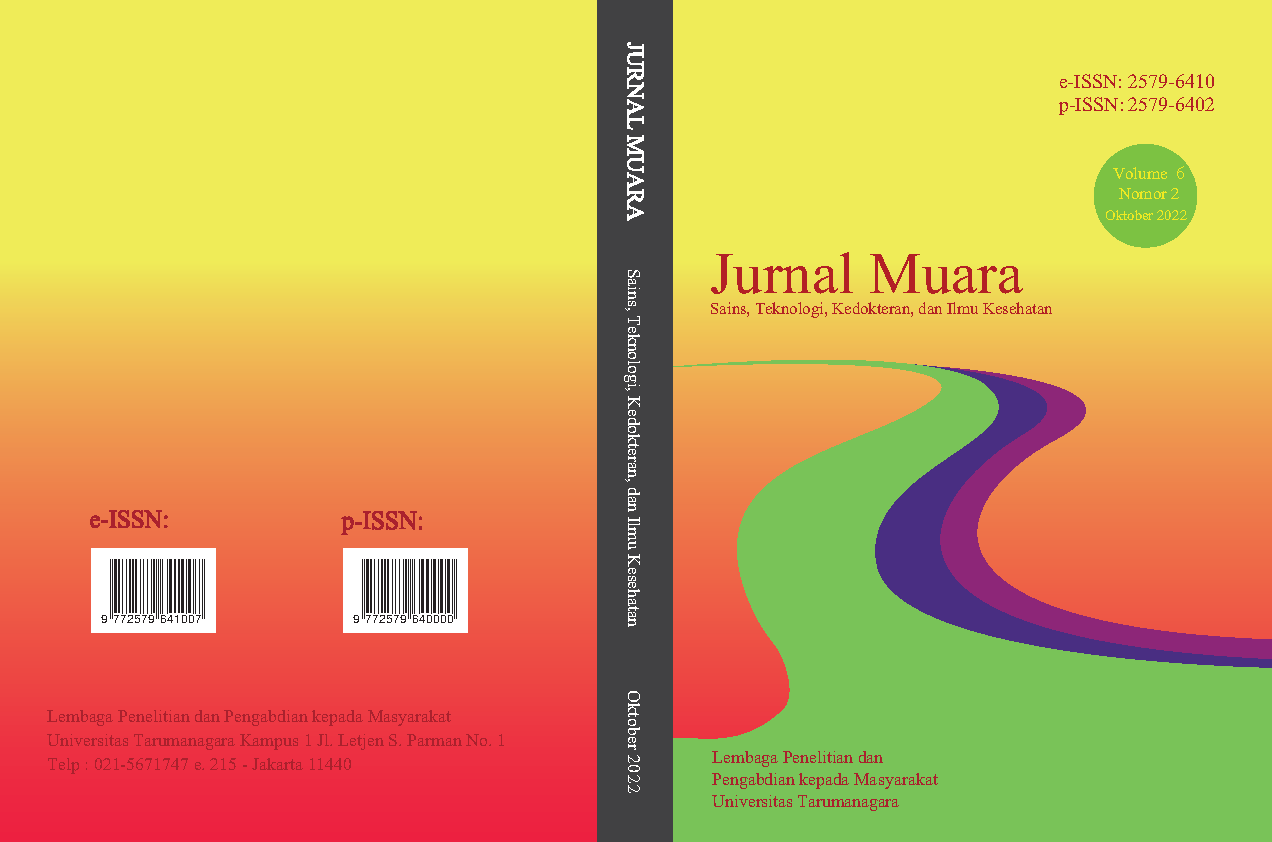PERBANDINGAN VALIDITAS PEMERIKSAAN ASAM URAT MENGGUNAKAN TIGA URIC ACID METER DENGAN BAKU EMAS STANDAR LABORATORIUM
Main Article Content
Abstract
Uric acid is an end-product from Purine metabolism, excreted in kidney. Hyperuricemia is resulted from either over production or decreased excretion of uric acid. Hyperuricemia results in uric acid crystallization or deposition in plasm and extracellular fluid. Deposition of uric acid crystal in synovial fluid cause arthritis, called gouty arthritis. In Indonesia, the prevalence of arthritis (including gouty arthritis) is 11,9%. Monitoring uric acid level is important for hyperurisemic patients, as an increased of acute episodes of gouty arthritis corresponds to the raised of uric acid level. Standard uric acid determination should be done in laboratory, but in daily practice, patient come to primary health center for monitoring, and uric acid meter is used to determine uric acid level. Prior studies reported that uric acid meters could be used in daily practice, yet in Indonesia, there has no published study comparing the validity of different brands of uric acid meter available in the market. This analytic cross-sectional study aimed to determine the validity of three uric acid meters (UA sure, Autocheck dan Easytouch) as compared to the gold standard Laboratory method. Data of 39 adult men and women who were selected consecutively were analyzed by using the Bland-Altman method, one-sample t-test and ordinary least-square regression. Result of this study showed that the validity of UA sure and Easytouch uric acid meters were suitably good, whereas the validity of Autocheck was unrealiable due to the present of fixed bias dan proportional bias.
Keywords: uric acid, hyperuricemia, gouty arthritis, uric acid meter
Abstrak
Asam urat adalah hasil akhir metabolisme purin yang diekskresikan melalui ginjal. Produksi berlebihan atau penurunan ekskresi, atau keduanya dapat menyebabkan hiperurisemia. Kadar asam urat yang berlebihan dapat menyebabkan kristalisasi dan penumpukan di plasma dan cairan ekstraseluler terutama di sendi sehingga mengakibatkan terjadinya radang sendi, yaitu artitis gout. Di Indonesia, prevalensi radang sendi, termasuk artritis gout sebesar 11,9%. Pada pasien hiperurisemia, pemantauan kadar asam urat sangat penting, karena angka kejadian artritis gout meningkat sesuai dengan tingginya asam urat plasma. Pemeriksaan asam urat standar dilakukan di laboratorium, namun pada prakteknya skrining kadar asam urat untuk pasien yang datang di layanan kesehatan primer sering dilakukan dengan menggunakan alat uric acid meter. Beberapa penelitian yang membandingkan hasil pemeriksaan asam urat dari laboratorium dengan uric acid meter melaporkan bahwa alat-alat tersebut dapat digunakan, namun di Indonesia belum ada penelitian yang membandingkan akurasi beberapa alat yang tersedia di pasaran. Penelitian ini merupakan penelitian analitik dengan desain potong lintang yang bertujuan untuk menilai validitas tiga alat uric acid meter (UA sure, Autocheck dan Easytouch) dengan baku emas standar laboratorium. Data kadar asam urat alat uric acid meter diperoleh dari sampel darah kapiler dan data kadar asam urat baku emas diambil dari sampel darah vena pada subyek yang sama dan waktu yang sama kemudian diukur dengan menggunakan metode enzymatic calorimetry di laboratorium standar. Data kemudian dianalisa dengan metode one-sample t-test dan ordinary least-square regression untuk membandingkan apakah terdapat bias pemeriksaan dari alat uric acid meter dengan baku emas. Pada penelitian ini didapatkan 39 sampel dengan hasil didapatkan UA sure dan Easy touch tidak mempunyai fixed bias (p=0,31; p=0,12) maupun proportional bias (p=0,91, p=0,42) terhadap baku emas, sedangkan Autocheck mempunyai fixed bias (p=0,001) dan proportional bias (p=0,006) bila dibandingkan dengan baku emas. Dari penelitian ini dapat disimpulkan UA sure dan Easy touch mempunyai validitas yang cukup baik, sedangkan Autocheck mempunyai validitas yang rendah.
Article Details

This work is licensed under a Creative Commons Attribution-NonCommercial-ShareAlike 4.0 International License.
This work is licensed under a Jurnal Muara Sains, Teknologi, Kedokteran dan Ilmu Kesehatan Creative Commons Attribution-ShareAlike 4.0 International License.
Authors transfer copyright or assign exclusive rights to the publisher (including commercial rights)
References
Bland JM, Altman DG. (1986). Statistical Methods for Assessing Agreement Between Two Methods of Clinical Measurement. Lancet, 307-310.
Dai KS, Tai DY, Ho P, et al. (20050. An evaluation of clinical accuracy of the Easy Touch blood uric acid self-monitoring system. Clin Biochem., 38(3), 78-81.
Fabre S, Clerson P, Launay JM, et al. (2018). Accuracy of the HumaSensplus Point-of-care Uric Acid Meter Using Capillary Blood Obtained by Fingertip Puncture. Arthritis Research & Therapy, 2018, 20:78
Giavarina D. (2015). Lessons in Biostatistics. Biochemia Medica, 25(2), 41-51.
Hung Y L, Ching T S, Sun T P, et al. (2011). The Accuracy of Commercial Blood Uric Acid Meters on Blood Uric Acid Level Measurement. Webmed Central. Biomedical Engineering, 2(3).
Kasper DL, Fauci AS, Hauser SL, et al. (2016). 19th Edition Harrison’s Manual of Medicine. McGraw Hill. New York. 863-865.
Kemenkes RI. (2013). Riset Kesehatan Dasar 2013.
Kuo CS, Hwu Cm, Lin YH, et al. (2001). Portable Electrochemical Blood Uric Acid Meter. Journal of Clinical Laboratory Analysis, 16, 109-114.
Kuo CF, Grainge MJ, Zhang W, Doherty M. (2015). Global epidemiology of gout: prevalence, incidence and risk factors.Nature Reviews Rheumatology, 11, 649–662.
Ludbrook J. (2002). Statistical Techniques for Comparing Measurers and Methods of Measurement: A Critical Review. Clinical and Experimental Pharmacology and Physiology, 29, 527-536.
Paraskos J, Berke Z, Cook J, et al. 2014). Analytical Comparison Between Point of Care Uric Acid Testing Meters. 2014 ACR/ARHP Annual Meeting.
Paraskos J, Berke Z, Cook J, et al. (2016). An Analytical Comparison Between Point-of-care Uric Acid Testing Meters. Expert review of Molecular Diagnostics, 16:3, 373-382.
Roddy E, Choi H. (2014). Epidemiology of Gout. Rheum Dis Clin North Am, 40(2), 155–175.



